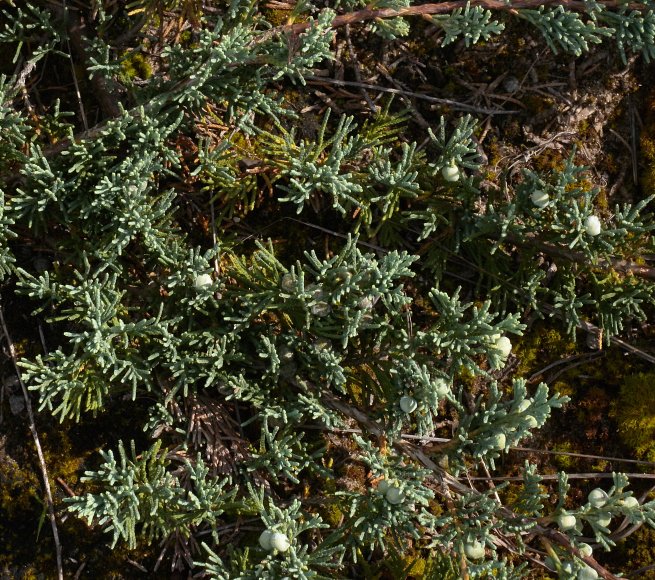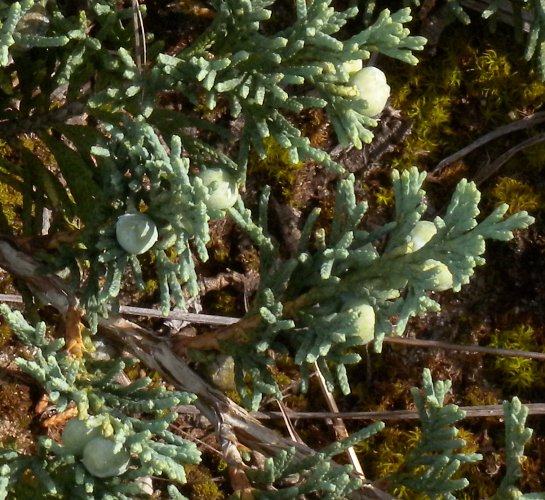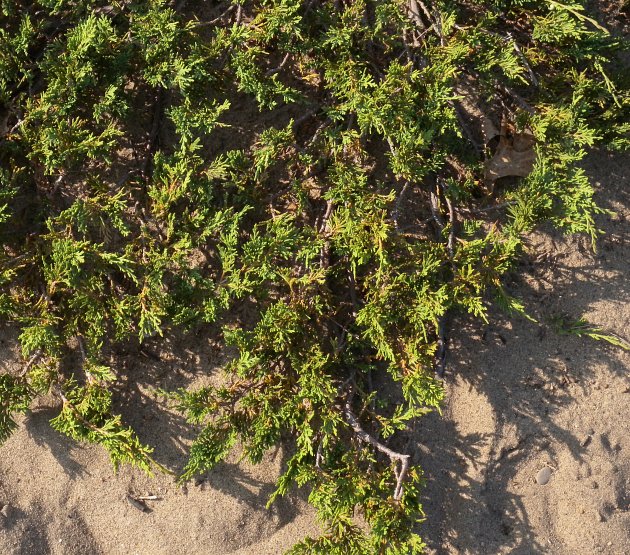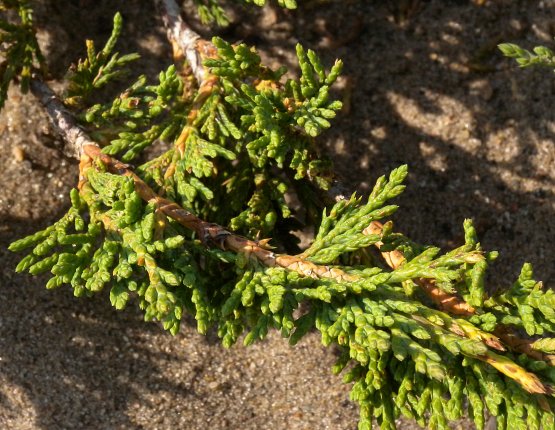
Because Creeping Juniper is dioecious, male (staminate) and female (pistillate) cones are produced at the tips of shoots on separate shrubs during late spring or summer. Each male cone has a cluster of yellowish stamens up to 5 mm. long. Each female cone consists of a cluster of small scales during its first year of development. Cross-pollination is accomplished by the wind. During the second year of development, each female cone becomes berry-like in appearance. At maturity, berry-like cones are 5-8 mm. across, more or less globoid in shape, and light blue from a glaucous coating. The interior of individual cones contains a stiff pulp that is resinous, and usually 1-3 seeds. Individual seeds are 3-5 mm. long and more or less ovoid in shape, although they are flat along one side and irregularly ridged. The root system is woody, shallow, and widely spreading. Creeping Juniper reproduces primarily by layering when above-ground branches dip into the ground, forming their own roots, and later detaching from the original shrub. Eventually, this process results in a colony of clonal shrubs. Less often, Creeping Juniper reproduces by reseeding itself.

Cultivation: The preference is full sun, relatively dry and well-drained conditions, and a calcareous soil containing sand or rocky material. This shrub can adapt to fertile soil containing loam or clay-loam, but taller plants should be kept away from it. This shrub is slow-growing, and in the wild it typically lives 20-140 years (Gucker, 2006). It tolerates hot weather during the summer and severe cold during the winter. Like Eastern Red Cedar (Juniperus virginiana), Creeping Juniper is a potential host plant of a fungal disease, cedar-apple rust.
Range & Habitat: Creeping Juniper is a rare shrub in Illinois, where it is restricted to sandy areas along Lake Michigan (see Distribution Map), and it is state-listed as 'endangered.' Most botanists within the state regard this shrub as native. Illinois lies along the southern range-limit of this species; Creeping Juniper is more common further to the north in Wisconsin and Canada. Within Illinois, habitats include partially stabilized sand dunes and upland sand prairies. Outside of the state, it is also found along the rocky slopes of Cedar glades, cliffs, and sandy pastures. Creeping Juniper is found in high quality natural areas in Illinois. It is also widely cultivated as an evergreen ground cover. While its foliage is initially reluctant to burn, this shrub is killed by wildfire, as its thin bark provides little protection (Gucker, 2006).

Faunal Associations: Creeping Juniper is a host plant of various insects that feed on the foliage or sap. These species include a flea beetle (Paria sexnotata), a plant bug (Bolteria luteifrons), two aphids (Cinara manitobensis, Cinara petersoni), a leafhopper (Texananus marmor), and larvae of two moths, the Juniper Webworm (Dichomeris marginella) and Red-striped Juniper Looper (Thera juniperata); see Clark et al. (2004), Wheeler et al. (1983), Blackman & Eastop (2013), DeLong (1926), Hamilton (1990), and Maier et al. (2011). Some of these insects have been found in Canada (e.g., Manitoba & Ontario) and the New England region, but not in Illinois. The berry-like cones and their seeds are eaten by some upland gamebirds and songbirds, including the Wild Turkey, White-winged Crossbill, Northern Flicker, Cedar Waxwing, American Robin, and Starling. Prairie Voles cache the berry-like cones and galls of Creeping Juniper in their dens for later eating, while Meadow Voles gnaw on the bark during the winter. White-tailed Deer browse on the evergreen foliage of this shrub, primarily during the winter and early spring, when palatable food is scarce (see Martin et al., 1951/1961; Gucker, 2006).
Photographic Location: A sandy beach along Lake Michigan at Illinois Beach State Park in Lake County, Illinois.

Comments: The remarkable thing about this shrub is how low and spreading it is. Creeping Juniper (Juniperus horizontalis) is closely related to the Eastern Red Cedar (Juniperus virginianus) as these two species can hybridize with each other. Such hybrids exist in the wild in the driftless section of southwest Wisconsin, for example, and they are also cultivated for landscaping purposes. These two species share the same scaly leaves and blue berry-like seed cones. However, Eastern Red Cedar is a tree, rather than a low spreading shrub. Another species, Common Juniper (Juniperus communis), differs from the preceding species by its needle-like leaves, and its seed cones require three years to develop, rather than two. Creeping Juniper is widely regarded as native to the lakeshore area of NE Illinois. However, Tehon (1942) regarded this shrub as non-native, stating that "Creeping Juniper or Creeping Savin, though not native to Illinois, was seeded on the Waukegan moorland nearly three-quarters of a century ago [about 1870] and now occurs there as an established naturalized species." He further states: "On the Waukegan moorland, it has developed from the original seeding as a low trailing shrub with bright steel-blue foliage which, in autumn, turns pale purple and becomes glaucus."